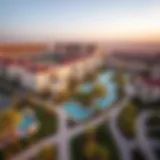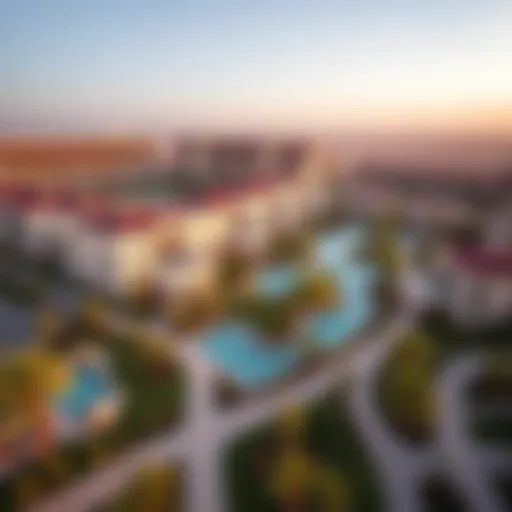Examining the Iconic Towers Shaping Dubai's Skyline
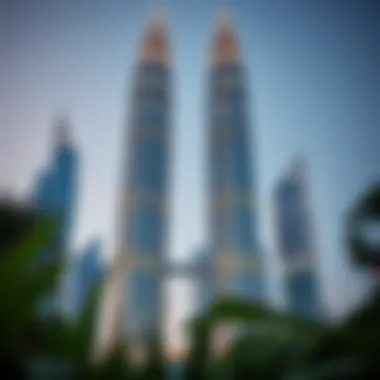

Intro
Dubai's skyline is not just a silhouette against the setting sun, it is a testament to human ingenuity and ambition. Among the towering giants that grace this mesmerizing city are two architectural wonders that have not only redefined aesthetics but also set a new benchmark in luxury and utility. These structures reflect countless hours of planning, innovative engineering, and an unwavering vision from both architects and developers.
In this exploration, we will journey through the distinctive design elements, construction methodologies, and ecological initiatives that characterize these towers. We will also consider the broader landscape of Dubai's real estate scene, providing vital insights for investors, developers, and stakeholders alike. Drawing on current market trends and neighborhood insights, this article aims to be a go-to resource for anyone considering involvement in this vibrant sector.
As we peer into the architectural marvel that are these towers, it's crucial to understand their implications on more than just the skyline—they serve as potent symbols of Dubai's rapid transformation and economic progress. Let’s turn our gaze to the broader property market to set the stage for our exploration.
Prelude to Two Towers
The architectural landscape of Dubai is peppered with extraordinary structures, and at its heart lie two towers that have become symbols of modernity and ambition. These towers not only contribute to the skyline but also reflect the aspirations and innovation that define this vibrant city. This section explores their significance, catering to stakeholders who seek a deeper understanding of their importance in both aesthetic and economic terms.
Definition and Importance
The term "Two Towers" typically refers to the twin structures that stand side by side, each embodying a unique architectural style while harmonizing within their shared environment. Their architectural significance goes beyond mere functionality; they represent the cutting-edge design and engineering prowess that Dubai is known for.
The importance of these towers can be broken down into several key elements:
- Iconic Status: They are not just buildings but landmarks that attract tourists and businesspeople alike, bolstering Dubai’s image on the global stage.
- Real Estate Impact: The towers play a crucial role in the local real estate market, influencing property values in their vicinity and enhancing investment opportunities for buyers and developers.
- Cultural Hubs: Often housing commercial spaces, offices, and luxury accommodations, these towers act as cultural intersections where creativity and commerce thrive.
The towers are emblematic of Dubai's growth trajectory, showcasing how architectural wonders can drive economic prosperity. Such buildings set the tone for urban planning and development, inviting investors who are eager to be part of this burgeoning market.
Historical Context
To fully appreciate the significance of these towers, it’s essential to dive into their historical context. The genesis of the twin towers is intertwined with Dubai's evolution from a modest trading town to a global metropolis.
In the late 20th century, during a period of economic diversification, the inception of these towers paralleled Dubai’s ambition to establish itself as a hub for commerce and tourism. They sprouted during an era when skyscrapers were not just a reflection of architectural might but were also seen as vital components of urban livelihood.
While the precise timeline of the towers’ construction may vary based on specific projects, it’s clear that their development reflects broader trends in global architecture. They have adopted influences from various cultures while integrating modern design principles, thereby encapsulating the essence of international cooperation in engineering.
Moreover, these towers connect the past with the present, offering a narrative of resilience and innovation. Over the years, they have hosted countless events, both local and international, serving as platforms for dialogues around sustainability, design, and urban living.
Through the lens of history, the Two Towers stand not just as structures of glass and steel, but as embodiments of a city’s dreams and desires, revealing the evolution of a society intent on redefining itself against the backdrop of an ever-changing world.
Architectural Design
The architectural design of the two towers in Dubai stands as a testament to innovation and meticulous planning. This section lays bare the specifics of their structural ingenuity, materials used, and sustainable features that not only elevate the towers aesthetically but also highlight their functional benefits. Understanding the design of these masterpieces is crucial, especially for investors and developers looking to tap into Dubai's thriving real estate market. A well-considered architectural design can greatly increase property value and attract prospective buyers.
Innovative Structures
At the heart of the two towers’ architectural design is their innovative structure, which transcends traditional ideas of skyscraper architecture. The unique tapering shape and dynamic facades are crafted to embrace both aesthetic appeal and structural integrity. This approach not only offers a modern silhouette against Dubai's skyline but also enhances the stability of the buildings, allowing them to withstand wind forces more effectively.
Additionally, the incorporation of smart building technologies sets these towers apart. Features like automated energy management systems allow for efficient energy use, fostering a sustainable environment. As investors increasingly favor properties with modern amenities and advanced structural designs, these innovative elements can significantly enhance the marketability of the towers.
Materials and Aesthetics
The choice of materials plays a pivotal role in the overall aesthetics of the towers. Engineers and architects have meticulously selected high-performance materials that reflect luxury while ensuring durability. Glass components dominate the exterior, not just for visual appeal but also for leveraging natural light, thereby reducing energy consumption. The reflective glass surfaces create a striking interplay of light and shadow, enhancing visual interest throughout the day.
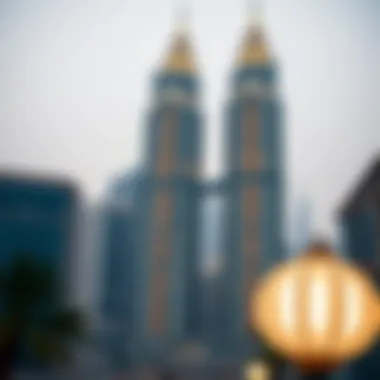

Moreover, the integration of traditional Islamic patterns into the modern design underscores Dubai's rich cultural heritage, weaving a narrative that resonates with both locals and international investors. Such thoughtful material selection exemplifies how architecture can serve as a bridge between the past and the future, making the towers not just landmarks but stories to be told.
Sustainability Features
In an era where sustainability is no longer just a trend but a necessity, the two towers bring this ethos to the forefront of their design. Features like rainwater harvesting systems and rooftop gardens significantly contribute to their ecological footprint, making them exemplary models of sustainable development.
For potential buyers and those looking to invest, properties that prioritize sustainability often see higher demand. A commitment to green building practices not only attracts environmentally-conscious tenants but also aligns with global trends pushing for more responsible real estate investment strategies.
"Buildings should not just serve as structures; they should enhance the environment and leverage natural resources."
The two towers are clear examples of how sustainability can be seamlessly blended into architectural design without compromising on luxury or functionality. With features that serve both the inhabitants and the environment, these towers prove that modern architecture can foster a more sustainable future.
To sum up, the architectural design of the two towers marries innovative structures, thoughtful material choice, and sustainability features, creating a living space that speaks to the sophistication and aspirations of Dubai’s residents and investors alike.
Construction Process
The construction process of the Two Towers is not just an architectural endeavor; it's a narrative of ambition and innovation that unfolds in real time. Each concrete slab laid, every beam installed, signifies much more than physical progress—it reflects Dubai's aspirations to carve its footprint into the skyline of modern architecture. Understanding this process is crucial for investors, developers, and stakeholders as it encapsulates the myriad of decisions, challenges, and triumphs that characterize such a monumental building project.
Project Timeline
The timeline for constructing the Two Towers was meticulously planned, with a dedicated focus on efficiency and quality. The project kicked off on January 15, 2014, with the ground breaking ceremony that set the wheels in motion for what would turn out to be a landmark construction journey. The initial phase involved extensive site preparation, including soil testing and groundwork, which laid the foundation for over three years of construction work.
In December 2017, the first tower was topped out, while the second followed suit in March 2018. The overall completion of both towers arrived in late 2019. This sequence of milestones not only illustrates the project's swift pace but also highlights the diligence and expertise of the workforce involved. Stakeholders closely monitored progress through key performance indicators, ensuring adherence to the projected timeline.
Challenges Faced
Building the Two Towers wasn't all smooth sailing. Various challenges arose, demanding innovative solutions and strategic adjustments.
- Weather Conditions: The extreme heat of Dubai posed significant risks during the summer months. For workers and materials, high temperatures can slow down productivity. Strategic work shifts were deployed to optimize construction activities during feasible hours.
- Regulatory Hurdles: Navigating local regulations was another crucial hurdle. Each phase of construction required compliance with strict legal frameworks. Engaging local authorities early on facilitated smoother transitions between different project stages.
- Logistical Complexities: Managing supply chains for materials was no small feat. Sourcing high-quality materials while ensuring that they were delivered on-time required coordinated efforts with suppliers and constant communication.
"The construction of the Two Towers serves as a reminder that every architectural success is rooted in overcoming challenges, both predictable and unexpected."
Technological Advancements
The application of cutting-edge technology played a decisive role in the construction of the Two Towers. Builders turned to advanced methodologies, including Building Information Modeling (BIM), which allowed for precise planning and visualization. This approach not only fostered increased collaboration among architects, engineers, and contractors, but it also minimized errors and wastage during construction.
Other technological contributions included:
- Drones for Surveying: Unmanned aerial vehicles were employed to provide rapid site assessments, allowing for real-time data collection and project monitoring.
- 3D Printing: Elements within the towers were prototyped using 3D printing technologies, expediting the design process and increasing customization possibilities.
- Smart Building Technologies: The incorporation of smart systems for energy management and security further enhanced the building's operational credibility.
Through embracing innovation, the construction of the Two Towers not only achieved its initial goals but set a benchmark for future developments in the region.
For more insights on construction practices and modern building technologies, you may visit Wikipedia or check other resources from educational institutions.
Economic Impact
Understanding the economic impact of the two towers in Dubai enhances our comprehension of their broader significance beyond mere architectural splendor. This analysis focuses on various specific elements like the effect on the local real estate market, investment opportunities that arise, and the overall contribution to tourism and business growth.
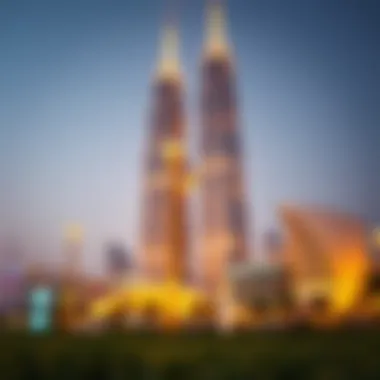

Effect on Local Real Estate Market
The introduction of the towers has undeniably shifted the dynamics of the local real estate market. Not only do these structures symbolize prestige, but they also influence property values across the vicinity. Homebuyers and investors often see these buildings as focal points, pushing prices up in surrounding areas. The buzz they generate serves as an attraction for both corporate tenants and affluent homeowners, which creates a trickle-down effect. Listings tend to appeal to a wealthier clientele, who often seek residences that promise views of these architectural giants.
In practical terms, neighboring developments have witnessed a notable increase in property demand. This is particularly evident in mixed-use developments that aim to offer amenities that complement the lifestyle associated with living near such iconic structures.
"The towers are not just buildings; they are catalysts for a thriving real estate ecosystem".
Investment Opportunities
A focus on these towers often leads investors to explore diverse opportunities in the adjoining sectors. For instance, firms may seek to capitalize on the increased foot traffic by developing retail spaces catering to tourists and residents alike. Ventures can include high-end retail shops, gourmet restaurants, and entertainment venues that offer experiences no less grand than the towers themselves.
Moreover, developments catering to the corporate sector are also on the rise. The presence of such architectural feats encourages tech firms and multinational corporations to establish a physical presence nearby, hence driving demand for office spaces. Investors can navigate through this evolving landscape:
- Commercial Leasing: A sound investment strategy may involve acquiring properties to lease to businesses taking advantage of the influx of clientele drawn to the towers.
- Residential Developments: Building or renovating residential properties for rental purpose can also yield high returns due to increased demand in the real estate sector.
Tourism and Business Growth
One cannot overlook the significant boost to tourism and local businesses brought on by the Two Towers. With their eye-catching designs and innovative engineering, they attract visitors from around the globe, eager to witness Dubai's architectural evolution. These millions of visitors usually look for a multitude of services:
- Hospitality Services, including high-end hotels and serviced apartments, see a spike in bookings during peak tourist seasons.
- Cafes and Restaurants thrive, especially those that offer views of the towers, creating memorable dining experiences that travelers cherish.
Additionally, events and exhibitions hosted within these towers provide a fertile ground for networking and business growth. Conferences and seminars frequently book venues here, which in turn stimulates the local economy. The accumulative effect signifies a flourishing commercial landscape that thrives on opportunity.
In summary, the two towers are not merely landmarks; they are significant drivers of economic activity in Dubai, shaping the landscape for real estate and business with their ongoing influence.
Cultural Significance
The two towers in Dubai stand not only as impressive structures of glass and steel but also as important cultural symbols within the rich tapestry of the United Arab Emirates. Their design and presence contribute to a narrative that reflects the evolving identity of Dubai, showcasing the city’s ambition and vision while bridging traditional values with futuristic aspirations.
In many ways, the towers embody the essence of cultural significance in modern architecture. Here, we explore two fundamental aspects:
- Symbolism in Architecture
The architectural features of the towers tell a story of ambition and modernity. Resembling the sails of a ship, their design pays homage to Dubai's rich maritime history. This connection emphasizes the city's roots, drawing a thread from its past as a fishing and pearl diving hub to its status today as a global business center. The choice of materials, predominantly glass and steel, reflects a commitment to modernity, lightness, and transparency, values that are in harmony with global architectural trends.Moreover, the heights of the towers symbolize the aspiration of the UAE to reach new heights in various sectors, be it tourism, trade, or technology. Coupled with carefully planned landscaping that integrates natural elements, these buildings provide a visual dialogue between the manmade and the environment, enhancing their status as cultural landmarks.
"Architecture is not just a matter of bricks and mortar; it’s a language that echoes the aspirations of a society."
- Community Engagement
Beyond their majestic structures, the two towers play a pivotal role in community engagement. They provide spaces for social interaction, businesses, and cultural events. The surrounding areas foster a sense of belonging by connecting residents and visitors alike to a shared identity rooted in diversity and innovation.The initiative to incorporate public art installations and green spaces further emphasizes their role as communal hubs. When local artists are featured in the public spaces, it encourages cultural dialogues and promotes community pride, showcasing the talents and stories of the inhabitants. Additionally, public events held in the vicinity create opportunities for social connection, engaging diverse populations and strengthening community bonds.
Thus, the cultural significance of the two towers transcends mere appearances. They are integral to Dubai's identity, bridging the heritage of the past with the dynamism of the future, and fostering community involvement in a rapidly changing urban landscape. Through careful consideration of symbolism and community engagement, these structures have positioned themselves as more than just architectural feats—they are cultural beacons in the desert.
Future Developments
The future developments associated with the Two Towers in Dubai offer a glimpse into how the architectural landscape and urban planning of the region will evolve. These structures, already iconic, are part of a broader narrative about growth, innovation, and community alignment in one of the world's most dynamic cities. Understanding these future plans is crucial for investors, property developers, and potential homeowners who are keen to navigate the real estate market effectively.
Expansion Plans
The expansion plans for the area surrounding the Two Towers highlight a commitment to enhancing urban living standards and accessibility. Proposed projects include new residential complexes, green spaces, and commercial hubs that aim to blend seamlessly with the existing architectural marvels. These aspirations not only focus on increasing the local population density but also enhancing the quality of life.
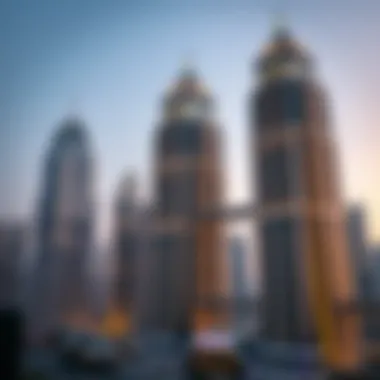

- Added Amenities: Upcoming community centers and retail options will provide a well-rounded living experience.
- Improved Infrastructure: There are discussions about better public transport links to reduce congestion and improve accessibility, which is vital as the area grows.
- Sustainable Development: Plans also emphasize eco-friendly designs, reflecting a broader societal commitment to sustainability, which aligns with global best practices in urban planning.
Through careful planning and investment, the future expansions promise to transform the immediate vicinity into a vibrant urban hub, attracting not just residents but also businesses eager to tap into this flourishing locale.
Upcoming Projects Nearby
Nearby projects are set to create a ripple effect of benefits that will not only enhance the Two Towers' prestige but also contribute positively to the local economy. These developments include:
- The Marina District: This sprawling residential area plans to introduce waterfront properties, giving residents stunning views and recreational spaces.
- A New Cultural Center: Scheduled to break ground soon, this facility aims to showcase local arts, heritage, and cultural events, fostering a rich community spirit that aligns with Dubai’s diverse background.
- Tech Hubs and Co-working Spaces: With tech startups on the rise, new co-working spaces are in the pipeline, creating a nexus for innovation and collaboration.
These projects, by enhancing the local infrastructure and providing new opportunities, will undoubtedly solidify the Two Towers as not just architectural landmarks but thriving focal points in Dubai's continually evolving skyline. Overall, as stakeholders keep a close watch on these developments, they reflect both immediate investment potential and long-term vision for the future of real estate in the area.
Comparative Analysis
In discussing the remarkable Two Towers in Dubai, a comparative analysis offers invaluable insights. This section allows us to juxtapose these iconic structures against both local and global architectural trends. By understanding how the Two Towers hold up against various benchmarks, investors, architects, and urban planners can glean deeper guidance on best practices and innovative possibilities.
Global Architectural Trends
In recent years, there has been a surge in modern architectural practices influenced by sustainability, technology, and aesthetic forms. The Two Towers are no exception, showcasing cutting-edge designs that respond to global trends.
- Sustainability: Globally, there's an upward shift toward environmentally friendly buildings. The Two Towers, with their energy-efficient systems and minimal carbon footprint, perfectly align with this trend. Key features like solar panels and advanced waste management systems are not just fanciful but essential in comparisons with other international structures, emphasizing responsibility in design.
- Smart Buildings: Another trend is the integration of technology within architectural frameworks. The Two Towers employ smart technologies that enhance operational efficiency. Sensors manage energy use, while smart elevators optimize traffic flow, making them standouts in the skyline. International counterparts have begun similar trends but few achieve the same level of seamless integration that Dubai’s towers do.
- Mixed-Use Developments: Providing space for both living and business, modern structures are increasingly turning toward mixed-use designs. The Two Towers serve as a bustling ecosystem of commerce, hospitality, and residence. This not only caters to urbanization effects but also respects the lifestyle choices of a diverse demographic.
Overall, the Two Towers exemplify a commentary on where the global architectural scene is headed, rather than merely following trends. Their unique position in Dubai's landscape provides a narrative that speaks to a broader shift towards innovation.
Case Studies of Similar Structures
Examining similar structures provides additional context about the Two Towers’ architectural significance. Here are a few noteworthy examples:
- Burj Khalifa: As the tallest building in the world, Burj Khalifa is often compared to the Two Towers in terms of height and overall impact. Both structures incorporate futuristic designs and advanced engineering but the Two Towers focus more prominently on sustainability and mixed-use functionality.
- Petronas Towers: Located in Kuala Lumpur, Malaysia, the Petronas Towers share similarities in dual-tower design. However, while they emphasize cultural representation, the Two Towers have a more contemporary approach to multifunctionality, addressing both living and business needs effectively.
- Taipei 101: This building represents a benchmark in skyscraper technology with its first-of-its-kind supertall design. While both Taipei 101 and the Two Towers push boundaries, the latter adopts a more integrated approach to community-centric design.
The comparison of these structures reveals unique strengths and highlights the individuality of the Two Towers. Innovations in design, sustainability, and mixed-use frameworks make them a model for future projects.
Beyond just form and function, these comparisons enrich our understanding of architectural evolution—placing the Two Towers not merely as isolated structures but as part of an ongoing dialogue in urban architecture.
Culmination
In reflecting upon the architectural journey of the two towers in Dubai, we find a profound understanding of their significance in both local and global contexts. These towers are not just mere buildings; they represent a marriage of innovation, cultural depth, and economic strategy in a rapidly evolving urban landscape.
Summary of Findings
The thorough examination of the two towers reveals several key findings:
- Architectural Excellence: The towers boast impressive designs that have set new standards in the field of architecture. Each element, from the facade to the interior, has been thoughtfully curated to reflect the rich cultural tapestry of the UAE.
- Historical Relevance: Their construction has marked a pivotal moment in Dubai’s relentless pursuit of modernity while holding onto its traditions. Understanding this historical context adds layers to their appreciation.
- Economic Movement: The presence of these towers has catalyzed growth in the local real estate market, presenting fresh investment opportunities and bolstering the tourism sector. Their impact extends beyond economics to fostering relationships among communities and businesses.
Despite the unique architecture of the towers, they align with global trends, catering to the needs of an ever-changing market. Investors, developers, and agents can glean valuable insights from their development, as they hold lessons that resonate across borders.
Future Implications
Looking ahead, the implications of these towers stretch beyond their physical structure:
- Inspiration for Future Projects: The successes and challenges encountered during their construction will likely inform future real estate endeavors. Emerging developers can draw lessons from the innovative designs and sustainable practices employed, ensuring continued growth in architectural excellence.
- Trendsetting in Sustainability: With an increasing global focus on sustainability, these towers serve as a standard for future architectural projects. The incorporation of green technology and environmental consciousness within their design showcases a forward-thinking approach that can attract like-minded investors and users.
- Cultural Icons: As the towers continue to gain international recognition, they may transform into symbols for the UAE, enhancing Dubai's reputation as a hub of innovation and culture. Such recognition may lead to increased tourism and facilitate cultural exchanges in the years to come.
"The two towers stand not merely as structures but as beacons showing the way towards a balanced merging of tradition and modernity."
In summary, the two towers in Dubai encapsulate a narrative of growth, innovation, and cultural significance. As they continue to influence the skyline and the market, they remain pivotal elements in the ongoing saga of Dubai’s architectural ambition.






